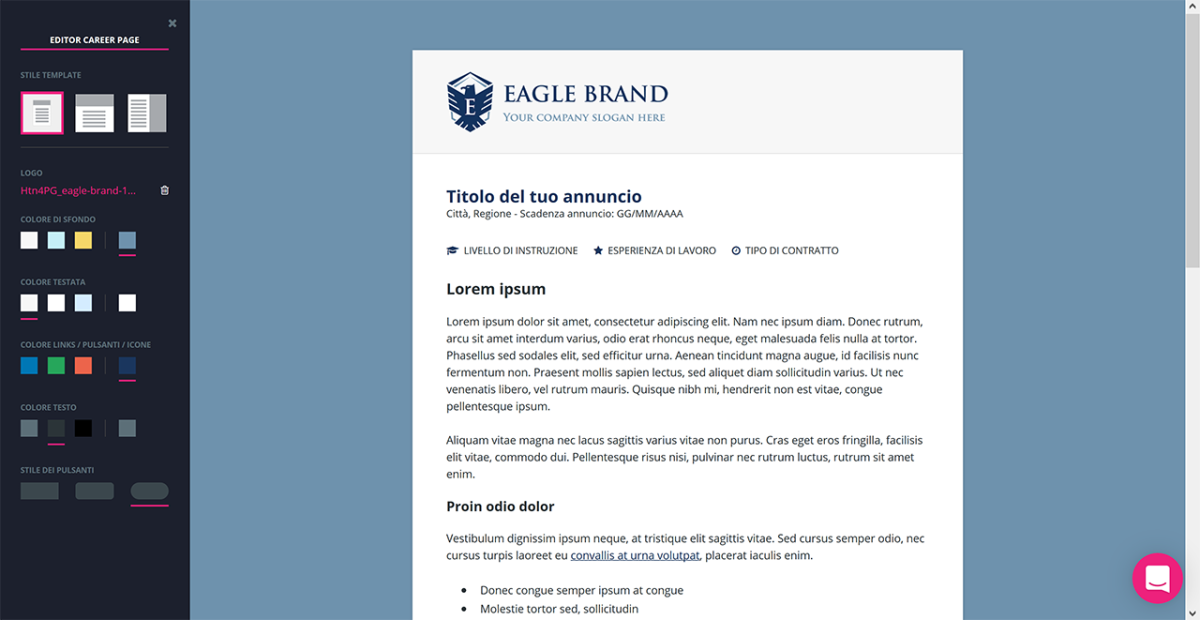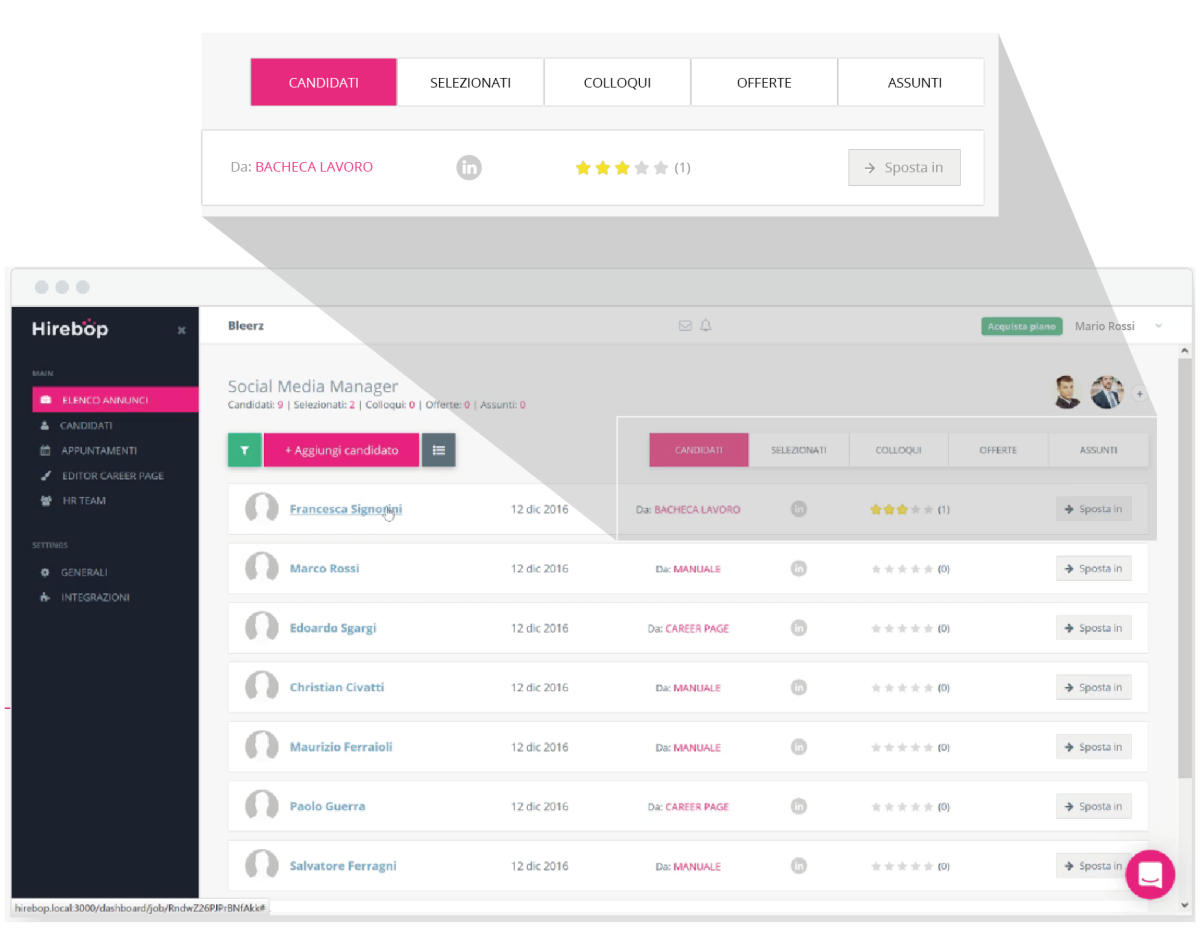RECRUITMENT: INCREASINGLY STRATEGIC, INCREASINGLY COMPLEX
Recruitment is a critical activity for many companies.
Nowadays’ context, where continuous changes and strong competition need companies to gather new skills and knowledge in a very short time, seeking new talents, becomes a strategic and complex task.
On one hand, the job descriptions entrusted to recruiters are more and more detailed and the competences hard to score; on the other, the applications that flow in recruiters desktops thanks to job-hunting sites and Linkedin, often do not match with the positions sought.
All this implies an extension of the screening process and therefore of time to hire. Recruiters devote a large part of their time on analyzing and discarding inappropriate applications, rather than concentrating on the most relevant ones.
Other sources of inefficiency can occur in managing the information and the complication of sharing it with other colleagues involved in the selection process. Hardships can also come from internal or external “clients” – companies’ managers who are seeking the new assets.
In the light of the above mentioned, those who are involved in research and selection – HR corporate managers, recruiting agencies and headhunters – seek to adopt tools that can help reducing the time to hire and can guarantee a more efficient management of the selection process in its entirety.
A key role is played by databases or management systems, used mainly to improve research, and the use of filters to skim applications. Many companies opt for even more complete software solutions: the so-called ATS (Applicant Tracking Systems)
WHAT IS AN ATS
An ATS is a software solution that allows one to manage the entire selection process: the creation of announcements, their publication, the applications-flow, the screening of CVs, the management of information on candidates and communications occurred with them.
An ATS keeps track of the candidate who applied for a position from the beginning to the end of the entire selection process, as if it were a customer that is traced in a CRM at the different stages of a commercial pipeline. An ATS can, in fact, think roughly as a CRM for the candidates, albeit with its own peculiarities.
The main benefits that can be achieved using ATS are:
- integration with all the recruiting channels available to a company,
- efficiency in automated collection of large quantities of applications and therefore profiles, and the creation of a database of candidates to be interrogated with advanced filters,
- a single tool recruiters can use for the management of the candidates’ career pages and the other research channels, the recruiting stages and the communication towards candidates.
The expected results from the use of an ATS are therefore:
- reduction of time to hire through the efficiency of the screening phase and the management of the entire selection workflow,
- the rationalized collection of applications and information of all applicants
HIREBOP, RECRUITMENT BECOMES AGILE
Having outlined the main features of the ATS in the previous paragraph, one can understand how much these tools can be useful to automate, speed up and make recruitment more efficient.
Although these features improve the recruiting performances, they actually do not give the chance to rethink the process in its entirety, making it agile. In terms of collaboration dynamics, the selection becomes a task of widespread and coordinated teams, and it goes without saying the workflow management through them.
This is possible thanks to the ATS developed by Interlogica, Hirebop, which allows recruiters to:
- organize the entire selection workflow as if it were a Kanban board,
- manage all stages in a widespread team by encouraging collaboration with people not directly involved in the selection process.
1. SELECTION WORKFLOW AS A KANBAN
In the software a selection workflow is displayed: all the candidates are inserted at the different stages of the selection process (incoming candidatures, those selected after screening, shortlist for the interviews, etc.) allowing a complete traceability.
Candidates can be seen as Kanban board tasks to be sorted and examined in a “pull logic” (selecting candidates to hire becomes the driver to run all other previous tasks).
In this case, selection can become methodical and systematic.
In short, this can be seen as thinking the selection process as a Kanban board that allows both to visualize the flow of activity in its entirety, allowing its measurement and management, and reduce the work-in-process at each stage.

2. RECRUITING AS A TEAM ACTIVITY (WIDESPREAD)
All the information concerning an application (entered by the candidates themselves or recruiters) and the communications, to and from the candidate, are recorded in their profile (e.g. the email thread, video interviews, chats..), since Hirebop features include the email gateway and video calls are built-in. Recruiters therefore have access to all the information needed to coordinate and work independently during the screening phases and in the stages of dialogue and interview with the candidates.
An extremely clean graphical interface allows any user, not only recruiters, to help themselves with all the functions of the application, and then start recruiting with no specific training.
Thanks to these functional features it is possible to set up recruiting teams that are not limited to those specializing in the HR field, but also to the “technicals” often involved in the selection process, experienced in their own function or in the area for the very position sought.
In doing so it becomes possible to divide the workload and collaborate with different professionals and build-up a real “recruiting team”.
It is also possible to extend the boundaries of the recruiting team to people outside the organization, such as headhunters or recruiting agencies; in this case, it also becomes possible to collaborate directly with other professionals, sharing information on selection and possibly monitoring the work of others.
All this enables the work of a team that is widespread and transversal to different functions and situations.

In conclusion, all these aspects can help to make recruiting a continuous and widespread activity within an entire company while maintaining the focus on the activities with maximum added value, in terms of management of the priorities and use of skills at the different stages of the selection.
YOU MIGHT ALSO LIKE:
From the designer’s toolbox: usability testing
I utilize, therefore I am



